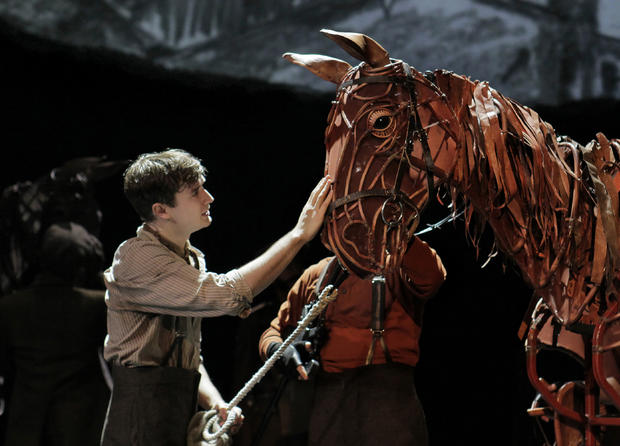The stage magic behind "War Horse"
A new play reminds us that horses were once on the front lines of war. With Martha Teichner, we have a front row seat.
World War I was the turning point, when tanks became the war horses of the 20th century.
And even though the tank on stage is made of aluminum and plastic, and the horse is a puppet, we comprehend what a terrible turning point it was.
"Tanks, I mean, they simply rolled over people, and they rolled through wire, and they obliterated
horses," said author Michael Morpurgo. "And it was that clash, then, of flesh and metal, of the machine and humankind, really, and we saw it with our own eyes, really, that this is the horrible future."
Web Extra: Michael Morpurgo on horses' military service
Morpurgo's young adult novel, "War Horse," has been turned into the National Theatre of Great Britain's most successful production, ever.
It opens this week at New York's Lincoln Center.
"War Horse" is the story of Joey, an English farm horse, and Albert, the boy who loves him.
Joey is sold to the British Army, to be sent to the battlefront.
The great adventure promised on enlistment posters soon became the horror of real war, for men and horses.
"These creatures had extraordinary courage to go on, as the men did, through the most appalling
Conditions, to charge on when they were being shot at," said Morpurgo. "They, of course, didn't have the comprehension of what was happening that we have, but nonetheless, the terror was quite clear to them.
"Their plight was total innocence. They were simply being used, exploited, for cavalry and for pulling ambulances, for pulling guns, they were simply being used and sacrificed."
The numbers are staggering: Ten million soldiers died in WWI, and it's believed about the same number of horses.
The story of "War Horse" is actually two stories - one about horses, the other about the extraordinary puppets that seem like living, breathing, feeling creatures on the stage.
They were created by South Africans Adrian Kohler and Basil Jones, partners in life and for the last 30 years, in the Handspring Puppet Company.
They demonstrated for Teichner a puppet hyena - a collection of pulleys and strings and little levers, like bicycle gears.
"Why do we forget it's not a real hyena?" she asked.
"We will things into life, said Adrian, "and when we're taken into a theater, the lights go down and a light comes up on an object, the audience is ready to allow that object to live. And if the puppeteers are any good, it just happens, and it seems like magic."
But the challenge of building larger-than-life horses was another order of magnitude.
First, Adrian Kohler studied actual horses - not only how they moved, but their anatomies.
The original Joey puppet took four months to build in Handspring Puppet Company's studio in South Africa, near Cape Town. Now it's down to three months.
Cane soaked in water is bent and molded to craft each horse's head and body.
The design suggests the skeleton and muscles of a real horse, but the materials actually were chosen to make each puppet lightweight ... and at the same time, strong enough to hold a rider.
The magic occurs when the three puppeteers - called the head, the hind, and the heart of the horse - take over, and become Joey.
For Kohler and Jones, breath is the fundamental of all movements in puppetry; they say if the puppet is breathing, the puppet is alive.
"The shiver of the skin, the flick of the ear, all have meaning," said Jones.
"The trick of the puppet is to allow the audience to say, 'OK, well, this is a real horse," Kohler said. "They [the audience] invent it."
Jones agrees: "They're making that meaning, and it's that activity that I think, that empathy, that's coming out of the audience, that really is what moves them."
In "War Horse," the boy, Albert, lies about his age and enlists, so that he can search for Joey. He endures the nightmare of combat, surviving on his belief that one day they will be reunited.
The truth of World War I can be seen on the memorials ... the long, long lists of names, a whole generation of young men gone. But they were remembered and mourned.
But what about the horses? In London, at least, there's a monument.
It is inscribed with these words: "They had no choice."
UPDATE: "War Horse" won five 2011 Tony Awards, including Best Play, Best Direction of a Play (Marianne Elliott and Tom Morris) and Best Actor in a Play (Mark Rylance). Handspring Puppet Company was also awarded a special Tony.
For more info:
- "War Horse"
- War Horse on Broadway
- National Theatre
- Michael Morpurgo's website
- ted.com (Handspring Puppet Company)
- Handspring Puppet Company
